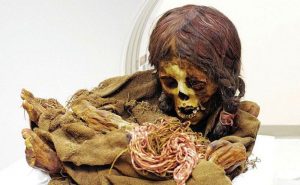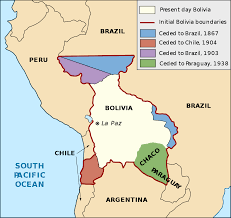My reviews mentioned finding more sources to provide more content in addition to translating the content of the Spanish page, as well as clarifying my proposed edits on the Talk page. This review has reminded me to assume the audience of the final page could know fairly little about the context of my person’s actions (Ruth Buendía) and specificity is a good quality to have both in the Talk page and the final live page.
Author Archives: Tristan
Ruth Buendía
This article does a fairly god job of summarizing the most important aspects of Buendía’s work as an indigenous activist and environmentalist. Although it doesn’t seem slanted, the English version stops at 2014 regarding her activity and lacks detail on her childhood (the Spanish version does a much better job of both of these matters, with a whole subheading regarding current problems she is tackling). To improve this, I would definitely rely on sources in Spanish to cite for the English article, because there should be much more information on what Buendía is doing in the current day – maybe even in relation to the recent press on Brazil’s fires.
Wikipedia Post: Guatemalan Revolution
I felt that every heading in the entry had a justifiable reason to be included.
Again, there was nothing that I found to be distracting or not immediately relevant.
There are times when the article spends its few words of a paragraph to mention personal opinions of the leaders (and therefore governments) during the Ten Years of Spring (e.g. Jorge Ubico saying that the indigenous population resembled donkeys). I can imagine some would say that this is not relevant to factual historical analysis but I feel that it holistically represents what would influence the contemporary administrations.
The viewpoints of women of the revolution felt especially lacking, considering there’s a list of three imprisoned leaders of a communist movement under Ubico where Graciela García, one of the only women mentioned by name in the article, doesn’t have her own page.
Yes; there are links to important players like United Fruit Company and the USA, and under the reference heading it seems almost as though they are the subject of the most articles.
The references listed seem to be from who I could incorrectly be assuming are not Spanish speakers, so that could skew primary source analyses from having to rely on translations.
The oldest article listed in as a reference is dated 1982, which while not out of modernity, is still before the fall of the USSR and being published in Texas could potentially have biased information regarding communist threads in the revolution.
This article has been deemed a “good” publication, and has a peer revision that is archived.
This is a part of the WikiProjects for Guatemala, the Cold War, and Military history.
The brief mentions of Guatemala we’ve had in class have regarded US-backed coups and the United Fruit Company, so it does make sense that great bulks of this article on the revolution regard both of these subjects.
Class Notes 9/4/2019
We began class with a few questions about the primary source essay, some notes about that:
- When quoting Spanish sources, it is not necessary to translate anything from the quote itself.
- You’re welcome (and encouraged) to use more than one supplementary source in addition to the chosen primary source.
We then received Kate’s presentation on an archaeological sacrificial site in Peru with children’s and llamas’ remains thought to have come about to avert the impending El Niño storm. This brought to mind perceptions of indigenous sacrifice (especially that of children) by the dominant Western European culture in the world.
We then reviewed something that was left out of the previous class due to time, which was the application of DeFronzo’s revolutionary framework onto the Mexican Revolution. However, we noted that it isn’t ethical to cherry pick evidence and force a certain framework onto a given subject, and were also trying to find ways that DeFronzo couldn’t sufficiently explain the Mexican Revolution. We supplied the following:
Mass frustration – economic depression, land ownership (and lack thereof), elites also dissatisfied & angered when Díaz goes back on promises
Permissive world context – Madero’s promises to foreign governments and corporations in the Plan of San Luis Potosí (p. 36 Wasserman), (mention of) the Zimmermann Telegram, and port blockades performed by the US in Veracruz and other cities
Unifying motivations – Madero as a figure, though this was very short lived (only weeks before insurrection)
Elite divisions – argument over Díaz’ succession between científicos and generals
Political crisis – the election to be held by Díaz (surely to be rigged)
We then spent time elaborating the concept of an ejido: a communally owned and operated piece of land in the context of Mexico, as mentioned by Zapata in the Plan of Ayala (p. 39). This is important because the concept had existed in indigenous communities and, being owned by families, was easier to buy out. Especially after the Marxist Revolution in Russia and the onset of global communist sentiments, it took on a convenient use in Latin American communist circles. Professor Holt mentioned an article by the New York Times in which the same idea of family-owned lands and homes are targeted and bought out by those who hold power; in this context, Black. She’s posted it on the home page.
We broke out into groups to go over the HAP, but ran out of time before we could return to discussion as a class. My group spent time discussing the Plan of San Luis Potosí from Madero as a primary source and the concept of democracy in Latin America in general, as well as how it’s historically been received as a proposed system. Professor Holt brought up a point about a popular argument used by white Europeans and those of European decent in Latin America being that democracy should be reserved for white spheres and that the indigenous mixing in Latin America makes it unachievable.
Further links:
- Brief summaries of a work, “Indigenous People and Democracy in Latin America” by Donna Lee Van Cott.
- A little more on the Chimú people, who would’ve performed the sacrifices mentioned in Kate’s article. They inhabited the western coast of Peru before they were conquered by the Inca.
- This is a pretty unique piece written about the experience of the authors in trying to establish a joint venture between a US company and an ejido in southern Mexico. It speaks on the background of ejidos in the country and some statistics on the status of them at the time of being written (1998). Consider why this interaction is being cast in a positive light, and whose voices are being showcased (politically, socioeconomically, concerning gender, etc.) and whose are not.
Questions:
- Can you think of ways that DeFronzo’s framework falters when applying it to the Mexican Revolution?
- The Mexican Revolution is often framed as being pushed by a single underlying cause or sentiment, when in reality it was a tumultuous and complex event with many different players and motivations. How could different political groups frame the revolution to their benefit in the years after (even today)?
- As shown by Wasserman, Díaz announced a plan to hold an election even though he held practically total power within the country. Parallels can be drawn between this and Pinochet’s decision to hold a plebiscite the 1980’s Chile. What motivations would Díaz have for doing this?
LA in the News: Incan Mummy Returned to Native Bolivia

After more than a century, the body of an ancient mummified Incan girl has been returned to her native land of modern-day Bolivia. It is estimated through carbon dating of maize located with her that she died roughly around the year 1470 at the age of eight.
She was discovered in 1890 in a stone tomb in the Andean highlands, along with various beads, sandals, and feathers, and immediately after was donated to the Michigan State University Museum by the US consul to Chile. She has since been known as Ñusta, or ‘princess’ in Quechua. After much deliberation on the part of the university, Dr. William A. Lovis, curator of anthropology for the museum, spearheaded and accomplished an effort to repatriate the girl to the government of Bolivia, the first of its kind in the anthropological field according to the article.
I felt the Latin America in this short article was portrayed as an object being affected by the actions of outside influences (i.e., the USA) as opposed to an actor with agency. It gives the impression that the mummy was taken from a hapless/disinterested government in 1890 that now, thanks to the altruism of these American museum curators, is content to have her back.
In regards to its relevance to the themes of our class, I felt that it rejects a lot of opportunity to speak on a few very questionable actions mentioned throughout, namely the inciting incident of the entire article. The language used lacks the kind of nuance and critique that I would expect when speaking on the removal of an indigenous mummified body from Latin America in the 19th century by American anthropologists with the goal to donate it to an American university; instead, this is done away with in one sentence at the beginning of the piece. Another example is the fact that in that sentence, it’s said it was the US consul to Chile that donated the body to the MSU Museum, but it was the country of Bolivia that it was returned to in the past months. Researching maps of the late 1800’s of both Chile and Bolivia only increased my confusion. I felt this was carelessly glossed over as if the audience would not notice the discrepancy in countries, and while I acknowledge it’s a stretch, I can’t help but think that it’s an extension of the perception that all of Latin America might as well be under the same name to many of the potential audience members of this article.
Lastly were the comments quoted from Lovis on the efforts for repatriation of the eight-year-old girl. He made a blog post explaining that Ñusta was removed from public display in the 1970’s once curators recognized the “changing societal sentiments toward the display of human remains” (Lovis 2019). It is then that the article says that Lovis tried in vain to garner interest in further research and testing on the body and its artifacts, and after failing he “came to the conclusion that, if nobody was going to be doing any work with either the artifacts or the humans remains and if we were not going to display the human remains, it would be better served to return them to Bolivia” (Solly 2019). Although reading through the entire blog post from Lovis, I gathered a sense that he understood the ethical implications of this entire ordeal, the article quotes him in such a way that gave me the impression of a cold and self-interested curator who has only changed his actions regarding the girl according to societal influences and disinterest from him peers in pursuing further investigation into the mummy’s background. In casual terms, that he thought “Well, if I can’t get any more out of the indigenous body I have, it might as well go back to where it came from, I guess.” Again, the entirety of the blog post gives a different impression from the article written about it.
Overall, the article treats the possession of (indigenous peoples’) human remains by non-indigenous people and the structures that have allowed that to happen with far less nuance and care that I would hope for and expect.
Here are links to the article and Lovis’ blog post.
References
Lovis, William A. “William Lovis: A Mummy Returns Home.” 360 Perspective, February 13, 2019. https://msutoday.msu.edu/360/2019/william-lovis-a-mummy-returns-home/.
Solly, Meilan. “500-Year-Old Inca Mummy Repatriated to Bolivia.” Smithsonian SmartNews, August 22, 2019. https://www.smithsonianmag.com/smart-news/500-year-old-inca-mummy-repatriated-bolivia-180972966/
